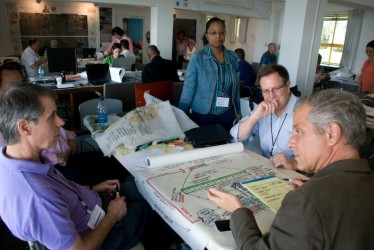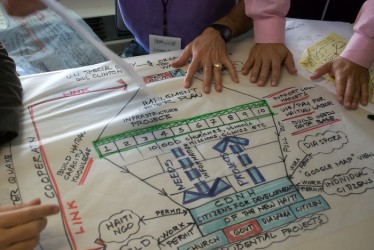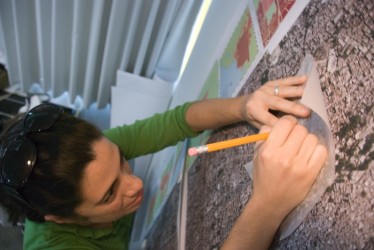
Design session: Architects, engineers, and planners from Haiti, the University of Miami, and the local community look over and discuss one of the many Bproposed projects for the Caribbean nation's reconstruction.
By ROBERT C. JONES JR.
University Communications
First through the door of the old Marion Manley-designed building on the University of Miami campus was the team of architects and planners from Haiti.
With pencils in hand and an eagerness to illustrate their best ideas for the “rebirth” of their nation, they toiled for hours over a group of cluttered drafting tables in the building’s first-floor design studio. They sketched the outlines of roads, houses, hospitals and schools, resting only to eat and stretch their legs.
In one corner of the design studio where they worked, a planner sitting in front of a laptop computer viewed satellite images of a severely damaged seaport. Off in another section, two others stood over a large drawing, pointing to an area where they thought a farmers’ market or perhaps a tourist attraction could be built.
It was in such a setting that a blueprint for the reconstruction of earthquake-ravaged Haiti began to take shape.
For five days in late March, Haitian architects, engineers and planners—unable to work effectively in their own studios back home because of an infrastructure still in ruins—gathered at UM’s School of Architecture to collaborate with professors, students, and architects from Miami’s local community on an ambitious post-disaster plan for the Caribbean nation’s recovery.
“There’s an urgency in what’s being done here,” said Elizabeth Plater-Zyberk, dean of the School of Architecture, as she worked at a drafting table on one of the many design proposals that were produced at the so-called Haiti Charrette. “Our hope is that the proposals have a long-term influence.”
During the charrette, which was held at UM at the request of the Haitian government’s Commission on Planning and Reconstruction, 12 design teams generated ideas ranging from building civic space projects such as churches, medical clinics, and community resource centers to restoring Port-au-Prince’s historic district.
Other proposals included promoting economic activity along the border with the Dominican Republic; developing hydroelectric, wind-generated, and other alternative sources of energy in outlying villages; creating pedestrian and green corridors; instituting setbacks along waterways to promote reforestation in the country; and erecting “starter shelters” for the displaced.
CREATING A NETWORK OF COMMUNITIES
But if there was one consistent theme and call for action that emerged from the five-day planning session, it was this: Haiti will need more than new construction and the repair of damaged buildings if it is to recover from the devastating magnitude-7 earthquake that left more than 230,000 dead and destroyed much of the country’s infrastructure. The country will need to decentralize its overcrowded urban core, and develop new communities in outer-lying regions where agriculture, tourism, and other industries can thrive and spur economic growth.
“The earthquake exposed problems that have long persisted in Haiti,” said Denis Hector, professor and associate dean of the School of Architecture who helped organize the charrette and for the past year has led an effort to renovate a 1940s-era hospital in the country’s Central Plateau. “Haiti is very centralized, with most of the services concentrated in Port-au- Prince.”
But after the quake destroyed much of Port-au-Prince on January 12, thousands of Haitians in search of better living conditions fled the capital for other parts of the country, straining communities that were unprepared for the mass migration.
From this unplanned exodus, an idea for Haiti’s reconstruction may have emerged. The Haitian government now wants to lessen the strain on an overcrowded Port-au-Prince and redistribute the population to a network of smaller, sustainable communities driven by agriculture, animal husbandry, tourism, the garment sector, and construction and housing, according to Leslie Voltaire, an urban planner and Haiti’s special envoy to the United Nations.
“We want to design neighborhoods, not camps,” he told an audience during the charrette’s pinup session last week at Miami’s Little Haiti Cultural Center.
To that end, architects and planners at the charrette introduced ideas to bring ecotourism, farms, marketplaces, and other businesses to Haiti’s hinterland, saying that such ventures could promote economic vitality.
Sonia Chao, assistant professor at UM’s School of Architecture, used the port at St. Marc as an example. Chao, who directs the school’s Center for Urban and Community Design, said the port, which has a deep harbor and is unaffected by the two fault lines that run through Haiti, could help spur the development of villages that surround it. Roads around the towns could be built and commerce could thrive because tourists arriving via the port could visit new
ecological attractions, spending money that would help create jobs and jumpstart the economy.
But along with the promise of Haiti’s revival comes immense problems, from the continued cleanup effort of massive amounts of rubble, which government officials estimate could take up to three years, to making sure homes that are being built by citizens themselves are constructed safely.

Detailed work: Planners created highly detailed drawings that included everything from new marketplaces, schools, and
BUILDING SAFER STRUCTURES
During a charrette planning session on the latter issue, Antonio Nanni, professor and chair of civil, architectural and environmental engineering at UM’s College of Engineering, proposed an idea of providing Haitian citizens with illustrated guidelines showing them how to build soundly and safely.
“We [the United States] have the best building codes in the world,” Nanni said. “But they are really of no use to people who don’t have engineering knowledge. We need to come up with something better than just telling Haitian citizens that we’ll translate those codes into Creole.”
Poor construction has been cited as one of the major reasons so many people perished in the quake. Charrette planners urged the Haitian government to adopt California’s stringent earthquake building codes and Florida hurricane construction regulations for its schools, churches, hospitals, markets, government buildings, and factories.
The charrette took place only days before a group of nations meeting at a donors conference in New York pledged an estimated $5.2 billion toward Haiti’s recovery.
 In the near future, as plans for the country’s reconstruction are solidified, Haitian government officials say they will travel from town to town, showing the Haitian people renderings and ideas for their country’s recovery. After receiving feedback, Haitian architects and government officials want to return with revised plans to UM’s School of Architecture, which will serve as a long-term support office for their efforts.
In the near future, as plans for the country’s reconstruction are solidified, Haitian government officials say they will travel from town to town, showing the Haitian people renderings and ideas for their country’s recovery. After receiving feedback, Haitian architects and government officials want to return with revised plans to UM’s School of Architecture, which will serve as a long-term support office for their efforts.
Said Voltaire: “We want everyone to participate in Haiti’s rebirth.”





